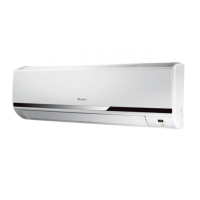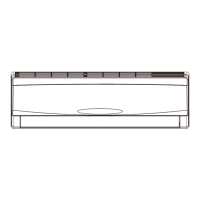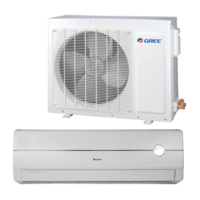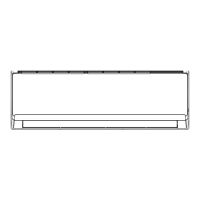35
Installation and Maintenance
Service Manual
detector prior to and during work, to ensure the technician is
aware of potentially toxic or ammable atmospheres. Ensure
that the leak detection equipment being used is suitable
for use with all applicable refrigerants, i.e. non-sparking,
adequately sealed or intrinsically safe.
● Presence of re extinguisher
If any hot work is to be conducted on the refrigerating
equipment or any associated parts, appropriate fire
extinguishing equipment shall be available to hand. Have a
dry powder or CO
2
re extinguisher adjacent to the charging
area.
● Ventilated area
Ensure that the area is in the open or that it is adequately
ventilated before breaking into the system or conducting any
hot work. A degree of ventilation shall continue during the
period that the work is carried out. The ventilation should
safely disperse any released refrigerant and preferably expel
it externally into the atmosphere.
● Checks to the refrigerating equipment
Where electrical components are being changed, they shall
be t for the purpose and to the correct specication. At all
times the manufacturer's maintenance and service guidelines
shall be followed. If in doubt,consult the manufacturer's
technical department for assistance.
The following checks shall be applied to installations using
ammable refrigerants:
- the actual refrigerant charge is in accordance with the
room size within which the refrigerant containing parts are
installed;
- the ventilation machinery and outlets are operating
adequately and are not obstructed;
- if an indirect refrigerating circuit is being used,the
secondary circuit shall be checked for the presence of
refrigerant;
- marking to the equipment continues to be visible and
legible.
Markings and signs that are illegible shall be corrected;
- refrigerating pipe or components are installed in a position
where they are unlikely to be exposed to any substance
which may corrode refrigerant containing components,
unless the components are constructed of materials which
are inherently resistant to being corroded or are suitably
protected against being so corroded.
● Checks to electrical devices
Repair and maintenance to electrical components shall
include initial safety checks and component inspection
procedures. If a fault exists that could compromise
safety,then no electrical supply shall be connected to the
circuit until it is satisfactorily dealt with.
If the fault cannot be corrected immediately but it is
necessary to continue operation, an adequate temporary
solution shall be used.
This shall be reported to the owner of the equipment so all
parties
are advised.
Initial safety checks shall include:
- that capacitors are discharged: this shall be done in a safe
manner to avoid possibility of sparking;
- that no live electrical components and wiring are exposed
while charging, recovering or purging the system;
- that there is continuity of earth bonding.
● No ignition sources
No person carrying out work in relation to a refrigerating
system which involves exposing any pipe work shall use
any sources of ignition in such a manner that it may lead to
the risk of fire or explosion. All possible ignition sources,
including cigarette smoking, should be kept sufficiently far
away from the site of installation, repairing, removing and
disposal, during which refrigerant can possibly be released
to the surrounding space.
Prior to work taking place, the area around the equipment
is to be surveyed to make sure that there are no ammable
hazards or ignition risks. ''No Smoking'' signs shall be
displayed.
● Repairs to sealed components
During repairs to sealed components, all electrical supplies
shall be disconnected from the equipment being worked upon
prior to any removal of sealed covers, etc. If it is absolutely
necessary to have an electrical supply to equipment during
servicing, then a permanently operating form of leak
detection shall be located at the most critical point to warn of
a potentially hazardous situation.
Particular attention shall be paid to the following to ensure
that by working on electrical components, the casing is not
altered in such a way that the level of protection is affected.
This shall include damage to cables, excessive number of
connections, terminals not made to original specification,
damage to seals, incorrect tting of glands, etc.
- Ensure that the apparatus is mounted securely.
- Ensure that seals or sealing materials have not de graded to
the point that they no longer serve the purpose of preventing
the ingress of ammable atmospheres.
Replacement parts shall be in accordance with the
manufacturer’s specications.
NOTE:The use of silicon sealant can inhibit the effectiveness
of some types of leak detection equipment.
Intrinsically safe components do not have to be isolated prior
to working on them.
● Repair to intrinsically safe components
Do not apply any permanent inductive or capacitance loads
to the circuit without ensuring that this will not exceed the
permissible voltage and current permitted for the equipment
in use.
Intrinsically safe components are the only types that can
be worked on while live in the presence of a flammable
atmosphere.
The test apparatus shall be at the correct rating.
Replace components only with parts specified by the
manufacturer. Other parts may result in the ignition of
refrigerant in the atmosphere from a leak.
● Cabling
Check that cabling will not be subject to wear, corrosion,
excessive pressure, vibration, sharp edges or any other
adverse environmental effects. The check shall also take
into account the effects of aging or continual vibration from
sources such as compressors or fans.
● Leak detection methods
Leak detection fluids are suitable for use with most
refrigerants but the use of detergents containing chlorine
shall be avoided as the chlorine may react with the refrigerant
and corrode the copper pipe-work.
● Detection of ammable refrigerants
Under no circumstances shall potential sources of ignition be
used
in the searching for or detection of refrigerant leaks. A halide
torch (or any other detector using a naked ame) shall not be
used.
The following leak detection methods are deemed acceptable
for all refrigerant systems.
Electronic leak detectors may be used to detect refrigerant
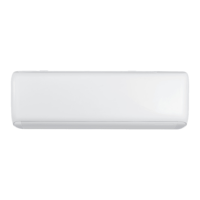
